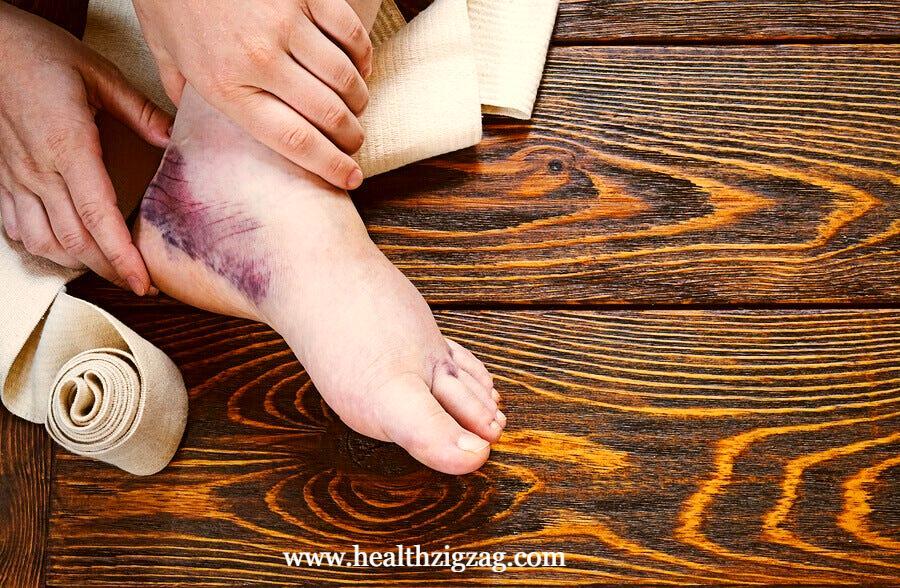
Contents
There are different degrees and types of sprains. Depending on the way in which the trauma occurs, and the intensity of it, there will be greater or lesser severity. Find out in this article.
The degrees and types of sprains are basically three, but they all have something in common: the involvement of a joint. A sprain is a ligament injury since the main structure affected is a ligament or several at the same time.
The ligaments, in question, belong to some joint. It can be a sprained ankle, wrist, knee, shoulder, among others. However, by far, the most common is the one that affects the ankle.
The ligaments are formed by fibers that have a certain elasticity. This physiologically allowed stretching gives mobility to the joints. The problem is that this flexibility is not infinite. When the movement exceeds the capacity of the ligament, then the injury occurs.
We could say that a sprain is the stretching of an articular ligament beyond its capacity, even with the possibility of a rupture. It is, in a sense, a dislocation as well, since the joint loses its stability line and the normal form of contact between the bones that form it.
The two groups most affected by sprains are athletes and the elderly. The former for frequent exposure to injuries related to exercise, and the latter for the lack of flexibility that ensues with age.
Read Also: Swelling In Legs, Feet, and Ankles – Causes, Symptoms, and Treatment
Risk factors for sprains
Before developing the degrees and types of sprains that exist, it is important to know what are the risk factors that predispose to the injury. Anyone can suffer it, but some are more exposed because of their physical condition or the activities they perform.
The most frequent risk factors are:
- Sports practice: the joints try harder in certain sports. The exercise overloads the ligaments and, in the long run, a wear sprain may occur. It can also happen unexpectedly due to trauma during practice or a bad footprint.
- Age: at an older age, there is less flexibility. The ligaments harden as time passes and the joints become stiffer. Of course, this factor is also influenced by the degree of physical activity that the person has performed during his life.
- Overweight: having more weight in our body, the joints have to bear a greater load. Even if you are not performing an impact sport, the obese body may suffer a sprain walking on flat ground. The joints of the lower limbs are the most affected.
- Sedentary: lack of physical activity deteriorates the joints. This can cause an injury when you try to perform an exercise that we are not accustomed to, or when you start practicing a sport abruptly.

Sprain symptoms
The primary symptom of a sprain is pain. The affected joint and surrounding tissues hurt. The same suffering can act as a limitation of functionality. Who suffers it refers to the inability to mobilize.
Along with the pain, there is inflammation in all grades and types of sprains. The damaged joint increases in size and swelling is another component that limits functionality.
The change in color is another sign. The stretching of a ligament is accompanied by the rupture of small veins and surrounding arteries. That will give rise to a bruise on the skin of the joint. The hematoma will vary its color according to the passage of days, according to the evolution of hemoglobin.
Finally, the temperature rise is recorded due to inflammation. Soft tissues feel hot around the joint due to the movement of inflammatory cells that migrate to the region.
Degrees and Types of sprains
As we anticipated, there are 3 degrees and types of sprains. Let’s see below the characteristics of each one.
First grade
The ligament stretches without breaking. It hurts like all sprains, but the pain is bearable. There is also inflammation, but the functional impotence of the joint may not be so extreme. Normal movements should be able to materialize.
The medical indications in these cases are not intensive. Some rest is necessary, but it can be limited to a few days. It is even a possibility not to indicate any anti-inflammatory.
Second grade
The ligaments not only distend in this case, but small tears of the ligament fibers appear. The pain is more intense than the first degree and the movements are quite limited.
Treatment involves immobilizing the joint for a time with bandages or splints. Anti-inflammatory, local cold placement, and elevated foot are also indicated.
Third-degree
It is the most severe form of sprain. The ligament stretches breaks and loses contact with any of the bones where it was inserted. It will require a surgical treatment that repairs the injured tissue. In addition, recovery will be slow, with much rehabilitation and rest.
In conclusion
There are different degrees and types of sprains. By practicing a sport of a certain intensity, we are more exposed to suffering an injury of this type. It is important to take the relevant precautions to prevent our ligaments from being damaged.
If you suffer a sprain it is important that you consult with a traumatologist. He will determine the extent of the injury and what is the best treatment to apply. It may be necessary to perform a complementary study to diagnose the degree of sprain you suffer. Published By Healthzigzag.com




